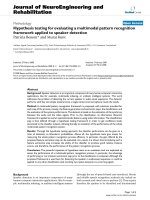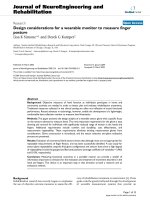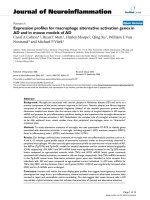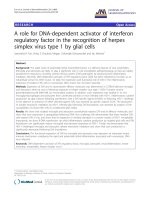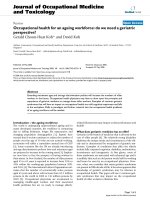báo cáo hóa học: " Sign-changing solutions for some nonlinear problems with strong resonance" pot
Bạn đang xem bản rút gọn của tài liệu. Xem và tải ngay bản đầy đủ của tài liệu tại đây (272.49 KB, 9 trang )
RESEARC H Open Access
Sign-changing solutions for some nonlinear
problems with strong resonance
Aixia Qian
Correspondence:
School of Mathematic Sciences,
Qufu Normal University, Qufu
Shandong, 273165, P. R. of China
Abstract
By means of critical point and index theories, we obtain the existence and
multiplicity of sign-changing solutions for some elliptic problems with strong
resonance at infinity, under weaker conditions.
2000 Mathematics Subject Classification: 35J65; 58E05.
Keywords: critical point theory, strong resonance, index theory, Cerami condition
1 Introduction
In this article, we consider the following equation,
−u = f (u),
u ∈ H
1
0
().
(1:1)
where Ω is a bounded domain in ℝ
n
with smooth boundary ∂Ω. In order to explain
what we mean, a brief description is necessary. We suppose that f is asymptotically lin-
ear, i.e.,
lim
|u|→∞
f (u)
u
exists. If we set
α := lim
|u|→∞
f (u)
u
,
(1:2)
then we can write
f (u)=αu − g(u)
with
g(u)
u
→ 0 as |u|→∞.
We denote l
1
< l
2
< <l
j
< to be the distinct eigenvalues sequence of -Δ with
the Dirichlet boundary conditions. We state that problem (1.1) is resonant at infinity if
a in (1.2) is an eigenvalue l
k
. The situation
lim
|u|→∞
g(u) = 0 and lim
|u|→∞
u
0
g(t)dt = β ∈ R
is what we call a strong resonance.
Qian Boundary Value Problems 2011, 2011:18
/>© 2011 Qian; licensee Springer. This is an Open Access article distributed under the terms of the Creative Commons Attribution
License ( icenses/by/2.0), which permits unrestricted use, distr ibution, and reproduction in any medium,
provided the original work is properly cited.
Now we present some of the results of this article. We write (1.1) in the following
form:
−u − λ
k
u + g(u)=0,
u ∈ H
1
0
().
(1:3)
We assume that g is a smooth function satisfying the following conditions.
(g
1
) g(t)·t ® 0 as |t| ® ∞.
(g
2
) the real function
G(t )=
t
0
g(s)ds
is well defined and G(t) ® 0ast ® +∞.
(g
3
) G(t) ≥ 0, ∀t Î ℝ.
Theorem 1.1 If (g
1
)-(g
3
) hold, then problem (1.1) has at least one solution.
Remark 1.1 Since0isaparticularpoint,wecannotmakesurethosesolutionsare
nontrivial without more conditions.
Theorem 1.2 Let g(0) = 0, and suppose that (g
1
)-(g
3
) hold, and
g
(0) = sup {g
(t ):t ∈ R}
(1:4)
then problem (1.3) has at least one sign-changing solution.
Theorem 1.3 Assume that (g
1
)(g
3
)hold,g is odd, and G(0) ≥ 0. Moreover, suppose
that there exists an eigenvalue l
h
< l
k
s.t.
g
(0) + λ
h
− λ
k
> 0.
Then, problem (1.3) possess at least m =dim(M
h
⊕ ⊕ M
k
)-1distinctpairsof
sign-changing solutions (M
j
denotes the eigenspace corresponding to l
j
).
Remark 1.2 In the article [1] , they only show the existence of solutions to problem
(1.3), while we obtain its sign-changing solutions under the same conditions.
The resonance problem has been widely studied by many authors using various
methods–see [1-6] and the references therein. We will use critical point and pseudo-
index theories to obtain the sign-changing solutions for strong resonant problem (1.3).
We also allow the case in which resonance also occurs at zero.
In Section 2, we will give some preliminaries, which are fundamental for this article.
In Section 3, we will give some abstract critical point theorems, which are used to
prove above theorems in this article. In Section 3, we prove our main theorems, which
result in the existence and multiplicity of sign-changing solutions.
2 Preliminaries
We denote by X a real Banach space. B
R
denotes the closed ball in X centeredatthe
origin and with radius R>0. J isacontinuouslyFrèchet differentiable map from X to
ℝ, i.e., J Î C
1
(X, ℝ).
In the literature, deformation theorems have been proved under the assumption that
J Î C
1
(X, ℝ ) satisfies the well-known Palais-Smale condition. In problems which do
not have resonance at infinity, the (PS) condition is easy to verify. On the other hand,
a weaker condition than the condition (PS) is needed to study problems with strong
resonance at infinity.
Definition 2.1 We state that J Î C
1
(X, ℝ) satisfies the condition (C) in ]c
1
, c
2
[(-∞≤
c
1
<c
2
≤ +∞)if
(i) every bounded sequence {u
k
} ⊂ J
-1
(]c
1
, c
2
[), for which {J(u
k
)} is bounded and J’(u
k
)
® 0, possesses a convergent subsequence, and
Qian Boundary Value Problems 2011, 2011:18
/>Page 2 of 9
(ii) ∀c Î] c
1
, c
2
[, ∃s, R, a >0 s.t. [c - s, c + s] ⊂] c
1
, c
2
[and∀u Î J
-1
([c - s, c + s]),
||u|| ≥ R :||J’(u)|| ||u|| ≥ a.
In the article [1], they propose a deformation theorem under the condition (C). For c
Î ℝ, denote
A
c
= {u ∈ X : J(u) ≤ c}, K
c
= {u ∈ X : J
(u)=0,J(u)=c}.
Proposition 2.2 [1] Let X be a real Banach space, and let J Î C
1
(X, ℝ )satisfythe
condition (C) in ]c
1
, c
2
[. If c Î]c
1
, c
2
[andN is any neighborhood of K
c
, then there
exists a bounded homeomor phism h of X onto X and constants
¯ε>ε>0
,s.t.
[c −¯ε, c + ¯ε] ⊂]c
1
, c
2
[
satisfying the following properties:
(i) h( A
c+ε
\N) ⊂ A
c-ε
.
(ii) h(A
c+ε
) ⊂ A
c-ε
,ifK
c
= ∅.
(iii) h(x)=x,if
x ∈ J
−1
([c −¯ε, c + ¯ε])
.
Moreover, Let G be a compact group of (linear) unitary transformation on a real Hil-
bert space H. Then,
(vi) h can be chosen to be G-equivariant, if the functional J is G-invariant. Particu-
larly, h is odd if the functional J is even.
3 Abstract critical point theorems
In this article, we shall obtain solutions of problem (1.3) using the linking-type t heo-
rem. Its different definitions can be seen in [1,7,8] and the references therein.
Definition 3.1 Let H be a real Hilbert space and A a closed set in H.LetB be an
Hilbert manifold with boundary ∂B, we state that A and ∂B link if
(i) A ∩ ∂B = ∅;
(ii) If j is a continuous map of H into itself s.t. j(u)=u, ∀u Î ∂B, then j(B) ∩ A ≠
∅.
There are some typical examples as following, cf. [1,7,9].
Example 3.1 Let H
1
and H
2
be two closed subspaces of H such that
H = H
1
⊕ H
2
,dimH
2
< ∞.
Hence, if A = H
1
, B = B
R
∩ H
2
, then, A and ∂B link.
Example 3.2 Let H
1
and H
2
be two closed subspaces of H such that H = H
1
⊕ H
2
,
dim H
2
<∞, and consider e Î H
1
,||e|| = 1, 0 < r <R
1
, R
2
, set
A = H
1
∩ S
ρ
, B = {u = v + te : v ∈ H
2
∩ B
R
2
,0 ≤ t ≤ R
1
}.
Then, A and ∂B link.
Let X ⊂ H be a Banach space densely e mbedde d in H. Assume that H has a closed
convex cone P
H
and that P := P
H
∩ X has interior points in X. Let J Î C
1
(H, ℝ). In the
article [10], those authors construct the pseudo-gradient flow s for J,andhavethe
same definition as [11].
Definition 3.1 Let W ⊂ X be an invariant set under s. W is said to be an admissible
invariant set for J if (a) W is the closure of an open set in X; (b) if u
n
= s(t
n
, v) ® u in
Qian Boundary Value Problems 2011, 2011:18
/>Page 3 of 9
H as t
n
® ∞ for some v ∉ W and u Î K,thenu
n
® u in X; (c) If u
n
Î K ∩ W is such
that u
n
® u in H,thenu
n
® u in X; (d) For any u Î ∂W\K, we have
σ (t, u) ∈
˚
W
for
t>0.
Now let S = X\W, W = P ∪ (-P). Similar to the proof described in the article [10], the
W is an admissible invariant set for J in the following section 4. We define
φ
∗
= {|( t, x):[0,1]× X → X is continuous in the X - topology and
(t, W) ⊂ W}.
In the article [7], a new linking theorem is given under the condition (PS). Since the
deformation still holds under the condition (C) (see [1]), the following theorem also
holds.
Theorem 3.1 Suppose that W is an admissible invariant set of J and J Î C
1
(H, ℝ)
such that
(J
1
)J satisfies condition (C) in ]0, +∞[;
(J
2
) There exists a closed subset A ⊂ H and a Hilbert manifold B ⊂ H with bound-
ary ∂B satisfying
(a) there exist two constants b > a ≥ 0 s.t.
J(u) ≤ α, ∀u ∈ ∂B; J(u) ≥ β, ∀u ∈ A
i.e.,
a
0
:= sup
∂B
J ≤ b
0
:= inf
A
J
.
(b) A and ∂B link;
(c)
sup
u∈B
J(u) < +∞
.
Then, a* defines below is a critical value of J
a
∗
=inf
∈φ
∗
sup
([0,1],A)∩S
J(u).
Furthermore, assume 0 ∉ K
a
*, then K
a*
∩ S ≠ ∅,ifa* >b
0
and K
a*
∩ A ≠ ∅,ifa*=
b
0
.
In this article, we shall consider the symme try given by a ℤ
2
action, more precisely
even functionals.
Theorem 3.2 Suppose J Î C
1
(H, ℝ)andthepositiveconeP is an admissible invar-
iant for J, K
c
∩ ∂P = ∅, for c>0, such that
(J
1
) J satisfies condition (C) in ]0, +∞[, and J(0) ≥ 0;
( J
2
)ThereexisttwoclosedsubspaceH
+
, H
-
of H, with codim H
+
<+∞ and two
constants c
∞
>c
0
>J(0) satisfying
J(u) ≥ c
0
, ∀u ∈ S
ρ
∩ H
+
; J(u) < c
∞
, ∀u ∈ H
−
.
(J
3
) J is even.
Hence, if dim H
-
>codim H
+
+1, then J possesses at least m := dim H
-
-codim H
+
-1
Qian Boundary Value Problems 2011, 2011:18
/>Page 4 of 9
(m := dim H
-
-1 resp.) distinct pairs of critical points in X\P ∪ (-P) with critical values
belong to [c
0
, c
∞
].
Remark 3.1 The above theorem locates the critical points more precisely than Theo-
rem 3.3 in [10].
We shall use pseudo-index theory to prove Theorem 3.2. First, we need the notation
of genus and its properties, see [10,12]. Let
X
= {A ⊂ X : A is closed in X, A = −A};
with more preciseness, we denote i
X
(A) to be the genus of A in X.
Proposition 3.2 Assume that A, B Î ∑
X
, h Î C(X, X) is an odd homeomorphism,
then
(i) i
X
(A) = 0 if and only if A = ∅;
(ii) A ⊂ B ⇒ i
X
(A) ≤ i
X
(B) (monotonicity);
(iii) i
X
(A ∪ B) ≤ i
X
(A)+i
X
(B) (subadditivity);
(iv)
i
X
(A) ≤ i
X
(h(A))
(supervariancy);
(v) if A is a compact set, then i
X
(A) <+∞ and there exists δ >0s.t.i
X
(N
δ
(A)) = i
X
(A), where N
δ
(A) denotes the closed δ - neighborhood of A (continuity);
(vi) if i
X
(A) >k, V is a k-dimensional subspace of X, then A ∩ V
⊥
≠ ∅;
(vii) if W is a finite dimensional subspace of X, then i
X
(h(S
r
) ∩ W ) = dim W.
(viii) Let V, W be two closed subspaces of X with codim V<+∞,dimW<+∞.
Hence, if h is bounded odd homeomorphism on X, then we have
i
X
(W ∩ h(S
ρ
∩ V)) ≥ dim W − codim V.
The proposition is still true when we replace ∑
X
by ∑
H
with obvious modification.
Proposition 3.3 [10,11] If A Î ∑
X
with 2 ≤ i
X
(A) <∞, then A ∩ S ≠ ∅.
Proposition 3.4 Let A Î ∑
H
, then A ∩ X Î ∑
X
and i
H
(A) ≥ i
X
(A ∩ X).
Now, we shall discuss about the notion of pseudo-index.
Definition 3.2 [1] Let
I =(, H, i)
be an index theory on H related to a group G,
and B Î ∑. We call a pseudo-index theory (related to B and I) a triplet
I
∗
=(B, H
∗
, i
∗
)
where
H
∗
⊂ H
is a group of homeomorphism on H,andi*:∑ ® N ∪ {+∞}isthe
map defined by
i
∗
(A) = min
h∈H
∗
i(h(A) ∩ B).
Proof of Theorem 3.2 Consider the genus
I =(, H, i)
and the pseudo-index the-
ory relate to I and B = S
r
∩ H
+
,
I
∗
=(S
ρ
∩ H
+
, H
∗
, i
∗
)
, where
H
∗
= {h|h is an odd − boun ded homeomorphism on H and h(u)=u i
f
u ∈ J
−1
(]0, +∞[)}.
Obviously, conditions ( a
1
)(a
2
) of The orem 2.9 [1] are satisfied with a =0,b =+∞
and b = S
r
∩ H
+
. Now, w e prove the condition that (a
3
) is satisfied with
¯
A = H
−
.Itis
obvious that
¯
A ⊂ J
−1
(] −∞, c
∞
])
, and by property (iv) of genus, we have
Qian Boundary Value Problems 2011, 2011:18
/>Page 5 of 9
i
∗
(
¯
A)=i
∗
(H
−
) = min
h∈H
∗
i(h(H
−
) ∩ S
ρ
∩ H
+
)
= min
h∈H
∗
i(H
−
∩ h
−1
(S
ρ
∩ H
+
)).
Now, by (viii) of Proposition 3.2, we have
i(H
−
∩ h
−1
(S
ρ
∩ H
+
)) ≥ dim H
−
− co dim H
+
.
Therefore we get
i
∗
(
¯
A) ≥ dim H
−
− codim H
+
.
Then, by Theorem 2.9 in [11] and Proposition 3.3 above, the numbers
c
k
=inf
A∈
k
sup
u∈A∩S
J(u), k =2, ,dimH
−
− codim H
+
.
are critical values of J and
J(0) < c
0
≤ c
k
≤ c
∞
, k =2, ,dimH
−
− co dim H
+
.
(3:1)
If for every k, c
k
≠ c
k+1
, then we get the conclusio n of Theorem 3.2. Assume now
that
c = c
k
= ··· = c
k+r
with r ≥ 1andk + r ≤ dim H
−
− co dim H
+
.
Then, simil ar to the proof of Theorem 2.9 [11], where K
c
is replaced by K
c
∩S and A
by A ∩ S, we have
i(K
c
∩ S) ≥ r +1≥ 2
(3:2)
Now, from Proposition 3.3 and (3.1), we deduce that
0 ∈ K
c
∩ S.
(3:3)
Since a finite set (not containing 0) has genus 1, we deduce from (3.2) and (3.3) that
K
c
above contains infinitely many sign-changing critical points. Therefore, J has at least
m := dim H
-
-codim H
+
-1 distinct pairs of sign-changing critical points in X\ P ∪ (-P)
with critical values belonging to [c
0
, c
∞
].
If codim H
+
=0,thenweconsiderc
j
for j ≥ 2. As per the above arguments,
J(0) < c
0
≤ c
2
≤ c
3
≤···≤ c
dim H
−
≤ c
∞
and if c := c
j
= = c
j+l
for 2 ≤ j ≤ j + l ≤
dim H
-
with l ≥ 1, then i(K
c
∩ S) ≥ l +1≥ 2.
Therefore, J has at least dim H
-
-1 pairs of sign-changing critical points with values
belong to [c
0
, c
∞
]. ■
Remark 3.2 Theorem 3.1 above can also be proved by the pseudo-index theory in
the same way as Theorem 3.2.
4 Proof of Theorems 1.1-1.3
We shall apply the abstract results of Section 3 to problem (1.3). Let
H := H
1
0
()
,
X := C
1
0
()
. Clearly the solutions of problem (1.3) are the critical points of the func-
tional
Qian Boundary Value Problems 2011, 2011:18
/>Page 6 of 9
J(u)=
1
2
(||u||
2
− λ
k
|u|
2
)+
G(u)dx,
(4:1)
where | · | denotes the norm in L
2
(Ω), and therefore, J Î C
1
(H, ℝ). We denote by M
j
the eigenspace corresponding to the eigenvalue l
j
.Ifm ≥ 0 is an integer number, set
H
−
(m)=⊕
j≤m
M
j
,
H
+
(m) = closure in H
1
0
() of the linear space spanned by {M
j
}
j≥m
.
Clearly H
+
(m) ∩ H
-
(m)=M
m
.
Proposition 4.1 [1] If (g
1
), (g
2
) hold, then the functional J defined by (4.1) satisfies
the condition (C) in ]0, +∞[.
Proof of Theorem 1.1 If G(0) = 0, then by (g
3
), G takes its minimum at 0, so that g
(0) = 0 and 0 is a solution of (1.3). We assume that G(0) >0. Similar to the proof as
for the case in [1], there exists R, g >0 such that
J(u) ≥ γ , u ∈ H
+
(k +1);
J(u) ≤
γ
2
, u ∈ H
−
(k) ∩ S
R
.
Let ∂B = H
-
(k) ∩ S
R
, A = H
+
(k + 1), then by Example 3 .1 we get that ∂B and A link,
and J is bounded on B = H
-
(k) ∩ B
R
. Moreover, by Proposition 4.1, J satisfies condition
(C) in ]0, +∞[. Therefore, the conclusion of Theorem 1.1 follows by Theorem 3.1. ■
Remark 4.1 If J(0) = 0, then the solutions obtained in Theorem 1.1 are sign-chan-
ging ones.
Proof of Theorem 1.2 Since g(0) = 0, u(x) = 0 is a solution of (1.3). In this case, we
are interested in finding the existence of sign-changing solutions to problem (1.3). The
case g(t)=0,∀t Î ℝ is trivial. We assume that g(t) ≠ 0forsomet. Then, it is easy to
see that (g
2
), (g
3
) and (1.4) imply g’(0) >0.SimilartotheproofasforTheorem5.1[1],
each of the following holds:
λ
1
− λ
k
+ g
(0) > 0
(4:2)
where l
k
≠ l
1
and there exists l
h
Î s(-Δ) with l
2
≤ l
h
≤ l
k
such that
λ
h
− λ
k
+ g
(0) > 0,
1
2
(λ
h−1
− λ
k
)t
2
+ G(t) ≤ G(0) ∀t ∈ R.
(4:3)
Under (4.1), there exist three positive constants r <R, g such that
J(u) ≥ J(0) + γ , u ∈ S
ρ
;
J(e) ≤ J(0) +
γ
2
, e ∈ M
1
∩ S
ρ
.
Since J(0) = G(0) · |Ω| ≥ 0(|Ω| is the Lebesgue measure of Ω), we have
0 < J(0) +
γ
2
< J(0) + γ .
Fix e Î M
1
∩ S
r
, set
A = S
ρ
; B = {te : t ∈ [0, R]}.
Qian Boundary Value Problems 2011, 2011:18
/>Page 7 of 9
Then, by Example 3.1, A and ∂B link and J is bounded on B. Moreover, by Proposi-
tion 4.1, J satis fies condition (C) in ]0, +∞[. Then, by Theorem 3.1, J possesses a cri ti-
cal point u
0
such that J(u
0
) ≥ J(0) + g.Sou
0
is a s ign-changing solution to problem
(1.3).
Under (4.3) with similar arguments as given above, we get
J(u) ≥ J(0) + γ , u ∈ H
+
(h) ∩ S
ρ
;
J(u) ≤ J(0) +
γ
2
, u ∈ ∂B(h, R).
where B(h, R)={u + te : u Î H
-
(h -1)∩ B
R
, e Î M
h
∩ S
1
,0≤ t ≤ R}. Set
A = H
+
(h) ∩ S
ρ
, B = B(h, R).
Then, by Example 3.2, A and ∂B link and J is bounded on B. Moreover, by Proposi-
tion 4.1, J satisfies condition (C). Using Theorem 3.1, we can conclude that J possesses
a sign-changing critical point u
0
with J(u
0
) ≥ J(0) + g. ■
Remark 4.2 If g’(0) = 0, i.e., resonance at 0 is allowed, then by using an argument
similar to that in the proof of Theorem 1.2, problem (1.3) still has at least a sign-chan-
ging solution under these conditions: Let g(0) = 0. Assume that (g
1
), (g
2
) hold and
G(t ) > 0, ∀t =0, G(0) = 0.
Moreover, suppose that either of the following holds:
λ
k
= λ
1
;
λ
k
= λ
1
and
1
2
(λ
k−1
− λ
k
)t
2
+ G(t) ≤ 0for∀t ∈ R.
Proof of Theorem 1.3 By Proposition 3.1 and Lemma 5.3 [1], the assumptions of
Theorem 3.2 are satisfied with
H
+
= H
+
(h), H
−
= H
−
(k).
Thus, there exist at least
dim H
−
− codi m H
+
− 1=dim{M
h
⊕···M
k
}−1
distinct pairs of sign-changing solutions of problem (1.3). ■
Remark 4.3 We also allow resonance at zero in problem (1.3). By using Theorem 3.2
and Lemma 5.4 [1], we have assumed that g is odd and that (g
1
)(g
2
) are satisfied. Sup-
pose in addition
G(t ) > 0for∀t =0andG(0) = 0.
Then, the problem (1.3) possesses at least dim M
k
- 1 distinct pairs of sign-changing
solutions. (M
k
denotes the eigenspace corresponding to l
k
with k ≥ 2)
Acknowledgements
The author is grateful to the anonymous referee for his or her suggestions. This study was supported by the Chinese
National Science Foundation (11001151,10726003), the National Science Foundation of Shandong (Q2008A03) and the
Science Foundation of China Postdoctoral (201000481301) and Shandong Postdoctoral.
Competing interests
The author declares that they have no competing interests.
Qian Boundary Value Problems 2011, 2011:18
/>Page 8 of 9
Received: 7 January 2011 Accepted: 30 August 2011 Published: 30 August 2011
References
1. Bartolo, P, Benci, V, Fortunato, D: Abstract critical point theorems and applications to some nonlinear problems with
strong resonance at infinity. Nonlinear Anal. 7, 981–1012 (1983). doi:10.1016/0362-546X(83)90115-3
2. Bartsch, T, Li, SJ: Critical point theory for asymptotically quadratic functionals and applications to problems with
resonance. Nonlinear Anal. 28, 419–441 (1997). doi:10.1016/0362-546X(95)00167-T
3. Li, SJ, Liu, JQ: Computations of critical groups at degenerate ciritical point and applications to nonlinear differential
equations with resonace. Houson J Math. 25, 563–582 (1999)
4. Molle, R, Passaseo, D: Nonlinear elliptic equations with large supercritical exponents. Calc Var. 26, 201–225 (2006).
doi:10.1007/s00526-005-0364-3
5. Qian, AX: Neumann problem of elliptic equation with strong resonance. Nonlinear Anal TMA. 66, 1885–1898 (2007).
doi:10.1016/j.na.2006.02.046
6. Su, JB, Zhao, LG: An elliptic resonant problem with multiple solutions. J Math Anal Appl. 319, 604–616 (2006).
doi:10.1016/j.jmaa.2005.10.059
7. Schechter, M, Wang, ZQ, Zou, WM: New linking theorem and sign-changing solutions. Commun Partial Equ. 29,
471–488 (2004). doi:10.1081/PDE-120030405
8. Struwe, M: Variational Methods. Springer, 2 (1990)
9. Schechter, M: Resonance problems with respect to the Fučik spectrum. Trans Am Math Soc. 352, 4195 – 4205 (2000).
doi:10.1090/S0002-9947-00-02655-6
10. Qian, AX, Li, SJ: Multiple nodal soltuions for elliptic equations. Nonlinear Anal. 37, 615–632 (2004)
11. Li, SJ, Wang, ZQ: Ljusternik-Schnirelman theory in partially ordered Hilbert spaces. Trans Am Math Soc. 354, 3207–3227
(2002). doi:10.1090/S0002-9947-02-03031-3
12. Rabinowitz, P: Minimax methods in critical point theory with applications to differential equations. CBMS Reg Cof Ser
Math. 65 (1986)
doi:10.1186/1687-2770-2011-18
Cite this article as: Qian: Sign-changing solutions for some nonlinear problems with strong resonance. Boundary
Value Problems 2011 2011 :18.
Submit your manuscript to a
journal and benefi t from:
7 Convenient online submission
7 Rigorous peer review
7 Immediate publication on acceptance
7 Open access: articles freely available online
7 High visibility within the fi eld
7 Retaining the copyright to your article
Submit your next manuscript at 7 springeropen.com
Qian Boundary Value Problems 2011, 2011:18
/>Page 9 of 9





